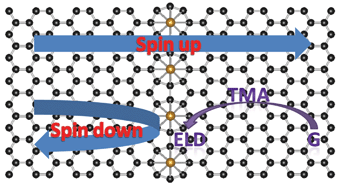First-principles study of 3d transition metal atom adsorption onto graphene: the role of the extended line defect
Abstract
A type of extended line defect (ELD) with two pentagons plus an octagon as the basic unit is currently an experimentally available topological defect in the graphene lattice, which brings about some interesting modifications to the electronic properties of graphene. Within the framework of density functional theory (DFT), we perform a systematic calculation to clarify the role of the ELD in 3d-transition metal atom (TMA) adsorption onto the graphene surface. We find that, in contrast to the ordinary lattice position of graphene, the ELD presents a much stronger adsorption for the TMAs(Sc–Cu). Thus, the presence of ELD provides a feasible approach to pattern magnetic impurities onto the graphene surface in a controllable and self-assembled way. In addition, our calculation indicates that as the adatom near the ELD alters from Sc to Cu, the spin moment and the adsorption energy show intricate variations. By means of symmetry analysis, we establish a hybridization picture between the TMA orbitals and the pz orbital of graphene, by which these numerical results are reasonably explained. Finally, by calculating the electronic transport properties based on the DFT and nonequilibrium Green function technique, we find that when the electron tunnels through an ELD with Co or Fe adsorption, the maximum spin-filter efficiency can reach 85% and 97%, respectively, with a bias voltage less than 0.6 V. Therefore, these composite structures of graphene with TMA adsorbed by the ELD can be considered as a prototype of a spin-filter device.


 Please wait while we load your content...
Please wait while we load your content...